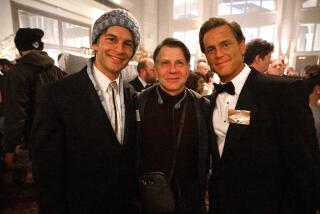This is how ‘Normal People’ made some of TV’s steamiest sex scenes
Before they spent five months playing lovers, the young stars of “Normal People” never so much as kissed.
Perhaps that doesn’t seem odd. Auditions don’t often require actors to prove their connection through a full-blown make-out session. But if you’ve already binged the 12-episode BBC/Hulu adaptation of Sally Rooney’s chart-topping novel “Normal People,” it’s hard to believe that Daisy Edgar-Jones and Paul Mescal just ended up naturally having that much physical chemistry.
“Normal People” isn’t about sex. It’s a quiet relationship drama that follows two Irish teenagers, Marianne and Connell, as they fall in and out of love over the course of their high school and collegiate years. But their intimacy is an integral part of the romance, and the way it’s depicted on screen is far more vulnerable and unhurried than in most Hollywood productions. Yes, there’s full-frontal nudity, but more impactful are the prolonged stares, breathy kisses and subtle skin grazes loaded with meaning.
So how do you make sex scenes between two total strangers — who swear, just like post-”A Star Is Born” Bradley Cooper and Lady Gaga, that they’ve never dated — look so real?
Hiring an intimacy coordinator, for starters. Lenny Abrahamson, who executive produced the series and also directed its first six episodes, admits he was initially hesitant when the idea was floated. He didn’t want Ita O’Brien — who has also coached actors on Netflix’s “Sex Education” and HBO’s “Gentleman Jack” — to come between him and the cast.
“You’ve got a very clear vision in your head, and my fear was that an intimacy coordinator would come in, it would all flow away from me and by the end they’d be swinging from the chandeliers,” acknowledges Abrahamson, best known for directing the 2015 film “Room.” “But having her there did loads of important things, even down to the really practical, like: How is it possible to make something look real, and at the same time give the actors the comfort that it isn’t?”
In adapting her novel “Normal People” for Hulu, Sally Rooney and director Lenny Abrahamson tried to “tap into the silence of the book” to capture its essence.
Of course, when Edgar-Jones and Mescal tried out for the show, both were made aware of what it would entail. The 21-year-old actress had “extensive conversations” with her mother before signing on to the project, ultimately deciding she was comfortable with the nudity because it was “incidental.”
“When Connell comes in from the shower, he just happens to be putting his shorts on,” she explains via video chat from her home in north London, where she was quarantined with her boyfriend and two flatmates. “Whether the camera captures [his nudity] or not, there is an honesty there of what a real relationship’s like.”
Mescal felt more at ease after an early discussion with the director in which he was reassured that Abrahamson wouldn’t be “didactic or forcing me into doing anything.”
“I think I told them,” recalls Abrahamson, “that, yes, there’s a contractual dimension so people know where they stand, but whatever it says in those, it’s not, like, ‘Oh, I’m allowed to show you guys full-frontal nude, so I’m just gonna do that randomly.’” He showed the potential cast nude photographs taken by Nan Goldin to give them an example the of “un-exploitative, beautiful” approach he wanted to emulate.
O’Brien weighed in during the casting process too, and felt confident that Mescal and Edgar-Jones could sell a connection despite the fact that she hadn’t watched them lock lips. “What you’re looking for is the electricity when they’re apart,” she says. “When you gradually bring those two magnets together, that’s what we can choreograph. That’s what chemistry is. It’s not about can two people actually kiss.”
Once the roles were set, O’Brien met with the two leads to explain her process: Forming intimacy guidelines that create a professional structure so the actors can separate themselves from the characters. Her three guiding principles? Open communication and transparency, agreement and consent of touch, and clear choreography.
During a two-week rehearsal period, the group worked through the most vital intimate scenes “while we were still wearing sweatpants,” Edgar-Jones says. They’d choreograph any lovemaking, mapping out the shapes of their bodies so that the cameras could catch all the correct angles.
“One of the things about making it realistic is that it’s about supporting your weight in ways that make it look like your bodies are in connection,” says Mescal, who is spending lockdown by himself in his apartment, save for a cardboard cutout of his family that his mother recently mailed to him. “My shoulders were incredibly strong at the end of the process, because you’re holding yourself up a lot of the time to give the right illusion.”
When shooting commenced, O’Brien would start each day by discussing with Abrahamson his vision for the day’s scenes. Then she’d circle back with Edgar-Jones and Mescal to run through any of their concerns before contacting wardrobe and double-checking that modesty garments like genitalia pouches or flesh-colored G-strings were in place. She’d also check in to make sure a triangle-shaped pillow was on set to place between the actors’ genitalia.
She left the majority of the directing to Abrahamson, chiming in only when a scene didn’t ring anatomically true. “Like on the first day, the actors were having spooning sex,” O’Brien says. “And I said ‘You have to move down further, because otherwise it looks like you’re having anal sex instead of vaginal sex.”
Although the leads had the previously outlined physical beats to guide them, “it wasn’t like, ‘Raise your right hand now and then count to three,’” notes Abrahamson. Instead of feeling boxed-in by the choreography, Edgar-Jones says it gave her an avenue to express herself more freely. Without worrying where she had to place her hands, she says, she could focus more fully on her acting.
“We had agreed where hands or lips could touch,” adds Mescal, “and there was a freedom both me and Daisy felt to express those impulses in the scene. It wasn’t regimented. If Lenny had turned to us and said, ‘This is the sex scene, try to make it feel real, wing it,’ then I think Daisy and I would feel incredibly insecure. Because suddenly we’re expressing our own sexual preferences, and that’s not interesting.”
“Normal People” also deals with how one obtains sexual consent. When Marianne is in college — and not seeing Connell romantically — she gets into a BDSM relationship with a new boyfriend. Even though she has asked for the power-play dynamic in the bedroom, it’s implied from the character’s body language that she isn’t actually enjoying it.
“I think it was important to show that Marianne is a vulnerable person, but she’s not just a victim in those scenes,” Edgar-Jones says. “And I do think there’s a really interesting conversation to be had about that: What is consent, and does it have to just be a verbal thing? It should also be sounding each other out and a constant dialogue, but it’s a tricky thing where the lines get blurred when someone asks for a specific kind of sex.”
“Mrs. America” depicts the battle over the Equal Rights Amendment in the 1970s. We’re fact-checking its historical accuracy, episode by episode.
While Abrahamson is clear he doesn’t feel the show is a “template for how real life should be,” he says he’s proud of the way the show handles intimacy. (To make the slow, heavy breathing as realistic as possible, he had the actors record breath tracks in post-production.) And although his children, ages 8 and 12, are currently too young to watch the show, he’s looking forward to showing it to them when they’re older as a “way of understanding how positive and incredible it can be.”
“How much stuff has been made which is kind of lazy or titillating or pornographic about sex and intimacy?” he continues. “That makes it all the more important that you can reclaim it and show it truthfully and honestly as part of life. Good sex — what a fantastic thing. And why should we be embarrassed about it? ... Sex feeds into a general sense of a person’s happiness — or lack of it — and is probably one of the central things in a human life. And yet in drama we go: It either has to be problematic or shocking or sensationalized or whatever. How about we’re actually able to talk about it in all its glory and difficulty?”
Which is all well and good, except for for the fact that “Normal People” is being released in the midst of a pandemic when singles cannot, in fact, have sex with anyone outside their shelter-in-place cohort.
“There should be a health warning on [the show], I think,” Abrahamson says with a laugh, noting he’s glad to be an “old, married father” living with his wife and two kids in Ireland at the moment. “You may need to have someone lock the door from the outside and stop you from running out and trying to find an open bar.”
More to Read
The complete guide to home viewing
Get Screen Gab for everything about the TV shows and streaming movies everyone’s talking about.
You may occasionally receive promotional content from the Los Angeles Times.







